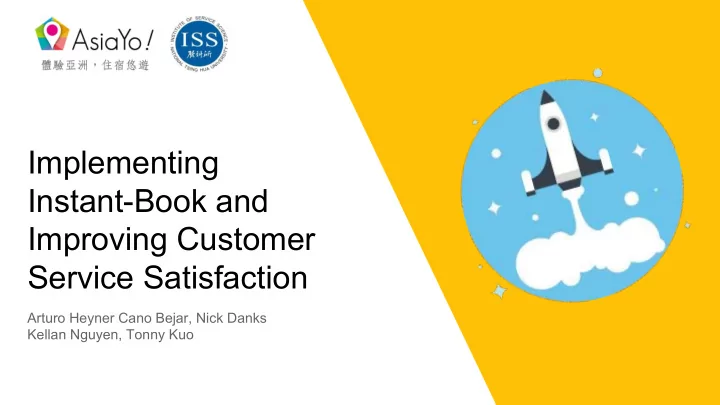

Implementing Instant-Book and Improving Customer Service Satisfaction Arturo Heyner Cano Bejar, Nick Danks Kellan Nguyen, Tonny Kuo
Business Problem Problem statement Stakeholder Opport. / Challenge Problem: high rejection AsiaYo Management Team Increase revenues rate (15%) → lost sales and Company will employ AsiaYo Customer Service customer dissatisfaction service team more Team efficiently . Strategy: Provide a tool for Guest / Host Manage AsiaYo! resources AsiaYo! to pipeline more efficiently. transactions according to Competitors: Airbnb, risk of rejection. Higher customer booking.com, Agoda satisfaction Goal: Implement Instant-Booking service
Data Mining Goal Data Mining Goal Outcome Variable Methods Predicting the probability 1. Probability of Classification - KNN of a transaction being rejection (%) - Classification Trees rejected by the host. - Logistic regression Low risk: instant-book 2. Binary for Rejection - Neural Networks (cut-off value very High risk: Service team - Naive Bayes important) Clustering similar facilities - Ensembles to offer alternatives to - Discriminant Analysis 3. Clusters of similar guests. Clustering facilities - Clustering analysis
● Data source and size: AsiaYo!, 65534 observations ● Unit of Analysis: One booking transaction ● Output: new.ack.status ● Input variables: ○ Predicting : Guests, nights, rooms, amount_paid, DOW.ci, DOW.created.at, advancebook, loc_popularity, nationality Data ○ Clustering : Accom_fac, room_fac, room_bath_fac, location
Methods & Performance Evaluation ● Task: Classification (supervised); Clustering (unsupervised) ● Benchmark: naive (the most popular class) ● Relevant performance measures: ○ False Positive (very important -> lost sales / increased effort by the team) ○ False Negative (host dissatisfaction, inactive host ) ● Relevance to business problem ○ Sales ○ Customer satisfaction
Implementation & Production Considerations Implementation ● IT team ● Service team: Manage high risk bookings ● R&D team: Develop different intervention ● Real time (At booking). Production Consideration ● One-time analysis ● The model should be re-analyzed weekly and sensitivity and specificity reviewed and costs re-evaluated
I update our new slides as belows Cover: Informative title, team number and member names ❏ Business problem (stakeholder, challenge/opportunity, humanity ❏ considerations) Data mining problem (supervised/unsupervised, explanatory/predictive, how ❏ to be deployed) Data description (what is a row? Output and input variables; partitioning) ❏ Methods (methods, relevant outputs) ❏ Evaluation (metrics of interest, benchmark, comparison) ❏ Recommendations ❏
Identifying high-risk rejection orders to improve customer service satisfaction Arturo Heyner Cano Bejar Nick Danks Kellan Nguyen Presenter: Tonny Meng-Lun Kuo Advisor: Prof. Galit Shmueli
Business Problem Problem statement Stakeholder Opport. / Challenge Problem: high rejection AsiaYo Management Team Increase revenues rate (15%) → lost sales and by less rejections and faster AsiaYo Customer Service customer dissatisfaction intervention Team Company will employ Strategy: Provide a tool for service team more Guest / Host AsiaYo! to identify high-risk efficiently . rejection orders. Competitors: Airbnb, Manage AsiaYo! resources booking.com, Agoda more efficiently. Goal: Rank transactions with high rejection prob. of Higher customer rate. satisfaction
Data Mining Goal Data Mining Goal Outcome Variable Methods Ranking the probability of a Binary for Rejection Classification - Logistics Regression transaction being rejected (cut-off value = 0.5) - KNN by the host. (supervised - Naive Bayes goal) - Discriminant Analysis Low risk: Normal intervention - SVM High risk: Direct intervention from Service team - Classification Tree - Boosted Trees - Random Forest Unbalanced data - Over-sampling
● Data source and size: AsiaYo!, 59265 observations ● Unit of Analysis: One booking transaction ● Output: is.rejected [derived from new.ack.status] ● Input variables: ○ Numeric: guests, nights, rooms, amount_paid, advancebook ○ Factor: DOW.ci, DOW.created.at ● Data partitions: Data ○ Training (40%), Validation (30%), Test (30%)
Methods & Performance Evaluation ● Task: Ranking (supervised) ● Benchmark: naive (the most popular class) ● Relevant performance measures: ○ Sensitivity ○ Lift Chart ○ False Positive (Important -> lost sales / increased effort of team) ○ False Negative (host dissatisfaction, inactive host)
Empirical Results (Descriptive data) # Records % is.rejected Method: Non-oversampling Training (40%) 29,632 15.13% Validation (30%) 17,779 14.69% Testing (30%) 11.854 15.50% Method: Oversampling Training (40%) 7,182 50% Validation (30%) 17,779 15.25% Testing (30%) 17,780 14.78%
Empirical Results (Non-oversampling) ● In non-oversampling, the performance of overall accuracy are similar (around 80%). ● Boosted tree and random forest are top two methods in sensitivity.
Empirical Results (Oversampling) ● In oversampling, KNN gets the highest accuracy but lowest sensitivity. ● Naive Bayes and discriminant analysis get better performance in in sensitivity.
Recommendation 1. This project identifies transactions with higher probability to be rejected using data mining algorithms to reduce dissatisfaction and increase profits. 2. Due to the unbalanced dataset and ranking goal , we suggest to adopt oversampling with Naive Bayes method to build the predictive model. 3. Although we can make the prediction based on the current datasets (accuracy = 0.69), more derived variables could be collected and included in predictive model for performance improvement. ● dynamic popularity: popularity of the properties at specific time ● property location: location of the properties ● host’s commitment: the degree of how hosts’ commitment to the platform ● Seasonal popularity: whether its a national/international holidays
Recommend
More recommend